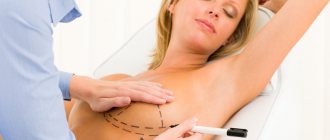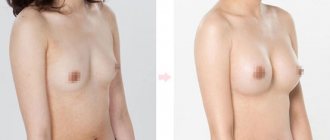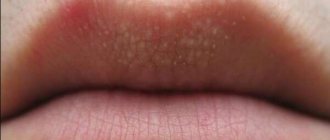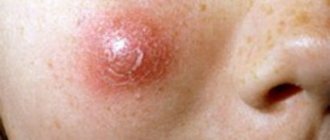Definition
Ripping after mammoplasty is a complication characterized by the formation of small folds, “waves” or “ripples” on the breast.
It represents a visual manifestation of the implant.
When the implant is positioned vertically, its upper part rolls into the lower part, and folds form at the top (typical of saline implants). When the skin is over-tensioned, these folds begin to appear.
Ripping may not appear when the glands are in a quiet position and can only be detected when the body is tilted or while walking.
A defect can occur due to the physiological characteristics of the body, insufficient volume of skin, incorrectly selected implants, violation of surgical technique, etc.
The likelihood of ripping directly depends on the size of the selected implants. The larger they are, the sooner a defect will occur.
Diagnostics
Complications that arise after surgery, in particular breast cancer, can be diagnosed using one of three studies:
- Ultrasound of the mammary glands allows you to recognize pathology at the earliest stages of its development. All changes in the glands after mammoplasty can be monitored using ultrasound. Ultrasound provides detailed information about the stage of seroma development.
- MRI – magnetic resonance imaging has a significant advantage due to the fact that there is no even the slightest dose of radiation and is carried out taking into account the individual characteristics of the patient’s body. MRI is used to monitor the condition of the breast after surgery. Tomography allows you to accurately determine the presence of contracture or seroma.
- Mammography - x-ray examination of the glands is contraindicated in girls under 40 years of age. However, a mammogram is recommended for anyone who has had any breast surgery. The study allows you to accurately determine the condition of the mammary glands, as well as detect the presence of fluid and neoplasms.
Why does it appear
Often, a similar effect appears after surgery, when the swelling subsides, but the skin still remains stretched, poorly contracted and gathers in folds. In this case, implants have nothing to do with it; this is a temporary phenomenon.
There are several factors that influence the risk of this complication:
- volume and elasticity of the skin and soft tissues;
- type and size of implant;
- place and technique of administration.
“Waves” most likely will not appear or will be barely noticeable if the volume of the skin is sufficient to properly cover the implant.
This is why ripping appears more often in petite women with a thin layer of fat and small mammary glands.
In obese patients with a pronounced layer of subcutaneous fat and initially voluminous breasts, this problem, on the contrary, does not exist.
In general, it is believed that the more implants are selected, the higher the risk of ripping.
The location of the prosthesis plays an important role. Submuscular placement of the implant (i.e., under the muscle) is preferable.
Thanks to this, a larger volume of soft tissue is formed over the prosthesis, and the muscles themselves have their own tone, which also helps hide the defect.
Since the muscle only covers half or 2/3 of the top of the implant, it is still possible for ripples to form in the area of the lower gland fold.
Photo: Ripling
But this place itself is hardly noticeable, and even with deep probing you can feel something, but not see anything special. That is why a little ripping is perceived quite normally here.
The pectoral muscles are usually well developed in the center and become thinner and flatter towards the outer border of the rib cage.
Therefore, when the prosthesis is inserted under the muscle, the outer edge of the tissue volume may not be enough, and ripples from the side become noticeable (especially when bending). If such a defect is unacceptable, you will have to opt for smaller implants.
Ideally, the width of the prosthesis should be less than the diameter of the mammary glands before mammoplasty.
The “washboard effect” often occurs when placing saline implants that are filled with saline solution.
In addition, in addition to the waves along the edges of the prosthesis, where there is a lack of native tissue, such implants give the effect of ripples over the entire surface of the gland.
This is the result of free movement of fluid inside the prosthesis when it is not filled enough. Ripping is especially pronounced when the implant is placed over the pectoral muscle.
Gel implants do not have this drawback, which is why most clinics now use them.
Regarding the surface, rough implants, compared to smooth ones, increase the risk of ripples.
This is due to the fact that your own tissues seem to “stick” to the textured surface.
But this point is relevant only when installing the prosthesis over the pectoral muscle, and not when inserting it subpectorally.
Repeated mammoplasty: analysis of the nuances of breast replacement
Re-endoprosthetics of the mammary glands is a common phenomenon. Women most often decide to undergo repeat surgery because of unsatisfied aesthetic results after augmentation mammoplasty. Many girls want to increase their bust another one or two sizes. The second most common reason for visiting a surgeon is an excessively voluminous plane for the material, as well as incorrectly selected shape or size of implants.
Another reason is the deformation of the silicone bust after childbirth. In this case, replacement of implants is accompanied by mastopexy, because gravitational ptosis increases under the weight of the prostheses.
You need to know that the procedure for secondary breast augmentation is technically more difficult, because... the doctor uses the same access and penetrates the tissue through the formed scars. This results in an increased risk of complications.
Indications
Today, mammoplasty is performed using fifth-generation implants. The material is made of cohesive gel and the manufacturers provide a lifetime warranty on the products. Thus, revision breast surgery is not performed due to the expiration date.
There are two categories of indications for replacing breast endoprostheses - aesthetic and medical.
The aesthetic group includes:
- Dissatisfaction with the result of the operation. The new breast is assessed only 7-9 months after the augmentation. Only after this period can a girl understand whether the result obtained corresponds to expectations.
- Incorrect material size. Implants can contour and bulge, which affects the appearance.
- Desire to change the shape of the bust. For example, if round endoprostheses were installed, then the idea arises to make the breasts more natural by installing anatomical implants.
- The desire to adjust the volume, i.e. reduce or increase the volume of glands.
- Asymmetry of the glands due to displacement in the formed bed.
- Lactation. After breastfeeding, the connective tissue stretches under the volume of colostrum. Subsequently, the shape of the mammary glands and the prostheses themselves change.
- Development of ptosis due to age. The tissues are stretched, and the plane in which the implants are located is deformed.
- Correction due to sudden weight fluctuations.
From a medical point of view, repeated breast surgery is performed under such factors as:
- Capsular contracture. About 30% of patients consult a doctor for this reason. A layer of tissue adhesions forms around the material. The capsule compresses the silicone, causing pain. In advanced situations, formation begins to be felt. An operation is required, which involves excision of scars and installation of new implants.
- Damage to the shell. Mostly appears as a result of some kind of injury. An urgent replacement of the material is necessary to prevent tissue inflammation.
- Displacement or palpation.
- Synmastia.
- Skin ripples.
Contraindications
Restrictions on replacing implants are standard and do not differ from the prohibitions on primary mammoplasty.
Advantages and disadvantages of re-endoprosthetics
Before surgery, you need to weigh the pros and cons:
| pros | Minuses |
| Asymmetry is corrected | Tissues are injured and recovery time is delayed |
| Bust size decreases or increases | Ptosis increases with increasing implant volume |
| Breast shape is corrected | Increased risk of complications |
Execution principle
As with the primary operation, it is necessary to undergo tests and examinations, during which it will be determined whether planned or urgent re-endoprosthesis is necessary.
Replacement of breast implants proceeds as follows:
- Removing old products. The doctor makes an incision using the existing scars and removes the implants if the indication is the formation of contracture or volume correction. Removal of ripping is performed using a new approach through a horizontal incision along the lower edge of the areola. If the procedure is complemented by a lift, then mastopexy is performed through a vertical incision from the areola to the inframammary fold under the glands.
- Capsulotomy. Depending on the complications and the density of the membrane, the fibrous tissue is completely or partially excised. After this, the plane is cleaned.
- Installation of new material. As a rule, dentures are implanted into an already formed bed. It expands if the implants are larger and is sutured and tightened for smaller ones. With advanced contracture, the location of the plane changes, i.e. the products are placed under the pectoralis major muscle, and the supramuscular bed is sutured.
If necessary, the process is completed with correction of the nipple-areolar complex and tissue tightening.
Finally, internal and external sutures are applied with biodegradable threads. The operation takes about four hours.
Recovery
Based on practice, rehabilitation after secondary mammoplasty takes longer. The postoperative period is prolonged and more traumatic if medical complications have been eliminated.
The patient feels pain, tingling, numbness of the entire bust, and in some cases, loss of sensation in the nipples. This is temporary until the implants take their final position, after which the discomfort goes away.
Basically, the doctor’s instructions during the recovery period are identical to the requirements of primary rehabilitation.
Complications
Some patients believe that if during primary mammoplasty the rehabilitation period was not accompanied by various kinds of complications, then they will not be present during re-endoprosthetics. After secondary breast surgery, the likelihood of developing negative phenomena increases several times. This is explained by the fact that scars take longer to heal as the connective tissue stretches and loses its elasticity.
If the patient removes the compression garment ahead of schedule, the seams may come apart.
Among the characteristic troubles after replacing implants, it is necessary to emphasize:
- Capsular contracture.
- Nipple discharge.
- Partial or complete loss of sensation.
- Hematomas and seromas.
- Double bubble effect (double fold).
- Keloid formation.
- Ripping (washboard effect or skin ripples).
To avoid trouble, you should follow all the surgeon’s recommendations and do not neglect wearing a special bra for two months.
What does ripping look like after mammoplasty?
Ripping looks as if your fingers ran across the iron and small “grooves” were left on the surface.
With a small amount of tissue, wrinkled breasts do not look particularly aesthetically pleasing.
The washboard effect is not a fixed defect. This means that it is usually invisible, but can be visualized while walking or bending over.
The ripples can be small and unnoticeable to others and can only be felt when running your hand over the skin.
Some women don't mind ripping at all if they find it acceptable. But for others, the defect becomes a real problem, which can only be solved surgically.
Photo: Implant shrinkage
Where is it formed
If the implant is inserted under the pectoral muscle, waves will most likely appear at the edges of the chest, since there are no muscles there to cover the prosthesis.
As you lean forward, the ripples become more noticeable as they pull on the skin.
Ripping occurs more often with the introduction of saline implants, especially if there is little natural fatty tissue in the mammary glands.
This effect is explained by the chemical properties of the water-salt solution that fills the prosthesis.
When placing gel implants, ripping is rarely a concern, since the viscous gel holds its shape well.
If implants are too large, the bust may take on a rectangular shape instead of a beautiful smooth outline. And in the area where the muscles cannot cover the prosthesis, pronounced skin wrinkling will occur.
Read when you will have your first period after mammoplasty.
What should breast care be like after mammoplasty? Details here.
What to do
There are ways to eliminate the problem, but they are all surgical. Therefore, it is better to try to avoid a defect during the initial consultation and surgery by choosing suitable implants and the method of their insertion.
Previously, ripping was eliminated by replacing saline implants with gel ones or by moving them under the mammary gland if they were installed above it (under the mammary glands).
Now, several solutions are available to solve this problem.
Implants can be replaced with high-density gel prostheses; they can be installed under the chest muscles; a dermal matrix can be introduced into the area where this complication is formed, which will hide the waves.
In some cases, the defect can be eliminated by introducing your own fat layer into the problem area.
If ripping is caused by the installation of a saline implant or its insertion above the pectoral muscle, the best solution is to repeat the operation and replace the saline prosthesis with a gel one (in the first case) and installing an implant under the muscle (in the second).
If the skin itself is thin and there is not enough gland volume, you can pay attention to the introduction of a dermal matrix (Alloderm). This technique will help reduce wrinkles.
Alternatively, you can transplant fat tissue, which will give your own tissues additional volume.
Another solution to the problem is to replace the prosthesis with a smaller one. But if you absolutely don’t want to change the size, it’s better to just leave everything as it is and not pay attention to the defect.
Treatment and prevention
When lymph accumulates in tissues and causes significant discomfort, there are several possible ways to solve the problem: medication and surgery. In some cases, if there is a large formation, it is necessary to combine both methods for maximum treatment effectiveness.
- The medicinal method of treating seroma is quite simple and includes taking antibiotics that have a wide spectrum of action, as well as anti-inflammatory drugs. If there is a small accumulation of fluid, doctors recommend using medications exclusively.
- To use the second method, drainage will be required. Installing a drainage tube allows you to get rid of lymph and other fluids within 2-3 days, depending on the volume of accumulated substances. To carry out the procedure, the surgeon makes punctures close to the wounds. In this case, regular treatment of the skin with brilliant green is required to prevent infection from entering the gland. A specialist strictly monitors the drainage and, if the tube falls out, performs an urgent replacement. The surgeon removes the drainage system.
- A third method of eliminating fluid by vacuum aspiration is also possible. During the procedure, the serous substance is completely pumped out of the wound or place of fluid accumulation. It is used in most cases at the very beginning of the postoperative period, which guarantees rapid healing of wounds.
Prevention of seroma is carried out in three stages: preoperative, interoperative, postoperative.
- Immediately before the operation, the patient must pass all the necessary tests, undergo a breast ultrasound and ECG, and consult with a qualified plastic surgeon and gynecologist.
- Interoperative prophylaxis is carried out by the surgeon. He selects a rational area for implantation, is responsible for the correct placement of incisions, adequate drainage during surgery and high-quality use of suture material.
- Postoperative prophylaxis rests entirely with the patient’s conscientiousness. The following rules are mandatory: regular visits to your doctor, wearing special underwear, and no excessive physical activity.
The procedure for getting rid of serous matter is quite simple and painless. Otherwise, the consequences can be quite serious. The main thing is not to skip consultations with a doctor and strictly follow his recommendations.
Risks and complications
In general, it is believed that ripping is not a classic surgical complication.
However, focusing on the possible dissatisfaction of patients, plastic surgeons try, whenever possible, to make any attempts to minimize the possibility of skin ripples.
This is more an aesthetic problem than a medical one, so, as a rule, there is no talk of serious risks and complications.
Not every patient is ready for a second operation, so most often everything is left as is.
Ripping can hardly be called a complication, since waves do not always appear, but only when the body bends forward or during active movements. It may be visually faintly noticeable, and only the woman herself can feel the unevenness.
Find out why breast pain occurs after mammoplasty.
Do scars appear after mammoplasty? Read more.
How long after mammoplasty can I play sports? Details here.










